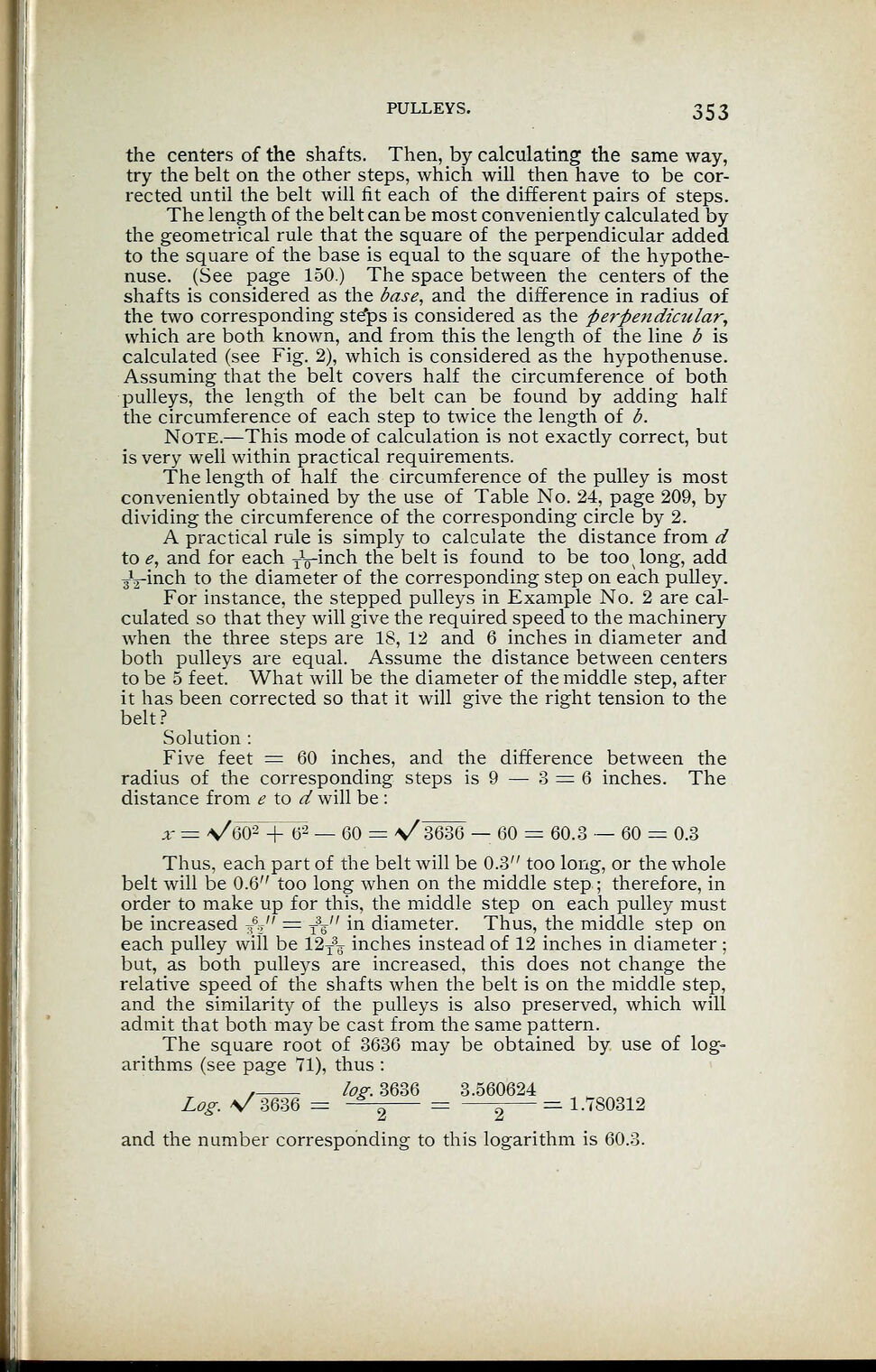
Full resolution (JPEG) - On this page / på denna sida - Pulleys - Stepped pulleys

<< prev. page << föreg. sida << >> nästa sida >> next page >>
Below is the raw OCR text
from the above scanned image.
Do you see an error? Proofread the page now!
Här nedan syns maskintolkade texten från faksimilbilden ovan.
Ser du något fel? Korrekturläs sidan nu!
This page has never been proofread. / Denna sida har aldrig korrekturlästs.
PULLEYS. 353
the centers of the shafts. Then, by calculating the same way,
try the belt on the other steps, which will then have to be cor-
rected until the belt will fit each of the different pairs of steps.
The length of the belt can be most conveniently calculated by
the geometrical rule that the square of the perpendicular added
to the square of the base is equal to the square of the hypothe-
nuse. (See page 150.) The space between the centers of the
shafts is considered as the base, and the difference in radius of
the two corresponding ste’ps is considered as the -perpendicular,
which are both known, and from this the length of the line b is
calculated (see Fig. 2), which is considered as the hypothenuse.
Assuming that the belt covers half the circumference of both
pulleys, the length of the belt can be found by adding half
the circumference of each step to twice the length of b.
Note.—This mode of calculation is not exactly correct, but
is very well within practical requirements.
The length of half the circumference of the pulley is most
conveniently obtained by the use of Table No. 24, page 209, by
dividing the circumference of the corresponding circle by 2.
A practical rule is simply to calculate the distance from d
to e, and for each y^inch the belt is found to be too long, add
aVinch to the diameter of the corresponding step on each pulley.
For instance, the stepped pulleys in Example No. 2 are cal-
culated so that they will give the required speed to the machinery
when the three steps are IS, 12 and 6 inches in diameter and
both pulleys are equal. Assume the distance between centers
to be 5 feet. What will be the diameter of the middle step, after
it has been corrected so that it will give the right tension to the
belt?
Solution :
Five feet = 60 inches, and the difference between the
radius of the corresponding steps is 9 — 3 = 6 inches. The
distance from e to d will be :
x = V(M2
~+¥2 — 60 = V3636 — 60 = 60.3 — 60 = 0.3
Thus, each part of the belt will be 0.3" too long, or the whole
belt will be 0.6" too long when on the middle step ; therefore, in
order to make up for this, the middle step on each pulley must
be increased gV = T%" in diameter. Thus, the middle step on
each pulley will be 12T\ inches instead of 12 inches in diameter ;
but, as both pulleys are increased, this does not change the
relative speed of the shafts when the belt is on the middle step,
and the similarity of the pulleys is also preserved, which will
admit that both may be cast from the same pattern.
The square root of 3636 may be obtained by use of log-
arithms (see page 71), thus :
, log. 3636 3.560624
Log. V 3636 = -^-g — g = 1.780312
and the number corresponding to this logarithm is 60.3.
<< prev. page << föreg. sida << >> nästa sida >> next page >>